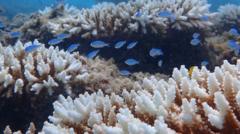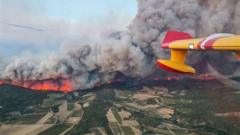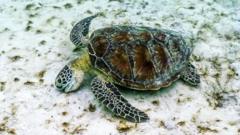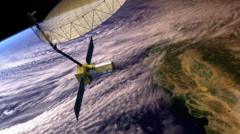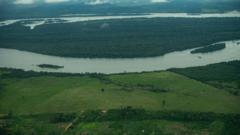This remarkable find highlights the need for conservation efforts in vulnerable regions like the Solomon Islands.
The Discovery of the Largest Coral in the Pacific: A Window to Underwater History

The Discovery of the Largest Coral in the Pacific: A Window to Underwater History
Scientists uncover colossal coral measuring 34 meters wide, shedding light on marine resilience amid climate change.
The world’s largest coral, a colossal specimen discovered in the southwest Pacific Ocean, is making waves in marine biology. This colossal organism, made up of numerous interconnected tiny creatures, has an estimated age of more than 300 years and measures 34 meters wide, surpassing even the size of a blue whale. The historic find was made by videographer Manu San Felix while documenting climate change impacts on the remote waterways of the Pacific during a National Geographic expedition.
San Felix, taken aback by the stunning sight, described the underwater coral as akin to witnessing a "cathedral." While exploring an area marked for a shipwreck dive in the Solomon Islands, he and his son Inigo came across the massive coral structure. “It’s very emotional to see something that has remained in place for centuries,” San Felix remarked, reflecting on how this extraordinary lifeform has endured since the time of Napoleon.
In good health, the newly discovered coral, identified as Pavona clavus, was found at depths that may have shielded it from the severe warming faced by shallower reefs. This feature of its environment is significant as scientists are reporting a worrying decline in coral health globally, with exacerbated climate conditions threatening the survival of these vital ecosystems.
The announcement coinciding with the UN climate conference COP29 in Baku, Azerbaijan, has further amplified awareness of the fragile state of coral. Trevor Manemahaga, the Solomon Islands' climate minister, expressed pride in the find, calling attention to the necessity of protecting such ecosystems for economic stability and environmental health. He underlined how marine resources, including corals, are central to the livelihoods of many in this island nation.
As discussions at COP29 continue regarding financial support for vulnerable nations, Manemahaga hopes for funding to foster sustainable job creation beyond industries that harm coral ecosystems. Presently, logging constitutes a major share of the country’s economy, posing a threat to marine health and pollution levels.
Experts accompanying the National Geographic team, including coral scientist Eric Brown, noted that this impressive coral formation acts as a beacon of hope amidst the deterioration of other reefs in warm coastal regions. The coral serves not only as a thriving habitat for numerous marine species, including shrimp and fish, but also provides insight into historical oceanic conditions, making it a crucial subject for further research.
In a concerning trend, the International Union for the Conservation of Nature recently reported that roughly 44% of warm-water coral species are currently under threat of extinction, marking a one-third increase since 2008. As climate change continues to impact the delicate balance of marine ecosystems, the discovery of this colossal coral marks a pivotal moment for both conservation efforts and our understanding of oceanic resilience.
San Felix, taken aback by the stunning sight, described the underwater coral as akin to witnessing a "cathedral." While exploring an area marked for a shipwreck dive in the Solomon Islands, he and his son Inigo came across the massive coral structure. “It’s very emotional to see something that has remained in place for centuries,” San Felix remarked, reflecting on how this extraordinary lifeform has endured since the time of Napoleon.
In good health, the newly discovered coral, identified as Pavona clavus, was found at depths that may have shielded it from the severe warming faced by shallower reefs. This feature of its environment is significant as scientists are reporting a worrying decline in coral health globally, with exacerbated climate conditions threatening the survival of these vital ecosystems.
The announcement coinciding with the UN climate conference COP29 in Baku, Azerbaijan, has further amplified awareness of the fragile state of coral. Trevor Manemahaga, the Solomon Islands' climate minister, expressed pride in the find, calling attention to the necessity of protecting such ecosystems for economic stability and environmental health. He underlined how marine resources, including corals, are central to the livelihoods of many in this island nation.
As discussions at COP29 continue regarding financial support for vulnerable nations, Manemahaga hopes for funding to foster sustainable job creation beyond industries that harm coral ecosystems. Presently, logging constitutes a major share of the country’s economy, posing a threat to marine health and pollution levels.
Experts accompanying the National Geographic team, including coral scientist Eric Brown, noted that this impressive coral formation acts as a beacon of hope amidst the deterioration of other reefs in warm coastal regions. The coral serves not only as a thriving habitat for numerous marine species, including shrimp and fish, but also provides insight into historical oceanic conditions, making it a crucial subject for further research.
In a concerning trend, the International Union for the Conservation of Nature recently reported that roughly 44% of warm-water coral species are currently under threat of extinction, marking a one-third increase since 2008. As climate change continues to impact the delicate balance of marine ecosystems, the discovery of this colossal coral marks a pivotal moment for both conservation efforts and our understanding of oceanic resilience.


